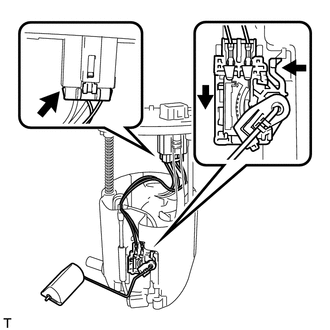Toyota Venza: Fuel Sender Gauge Assembly
Components
COMPONENTS
ILLUSTRATION

Removal
REMOVAL
PROCEDURE
1. DISCHARGE FUEL SYSTEM PRESSURE
(a) Discharge fuel system pressure (See page
.gif) ).
).
2. DISCONNECT CABLE FROM NEGATIVE BATTERY TERMINAL
NOTICE:
When disconnecting the cable, some systems need to be initialized after the cable
is reconnected (See page .gif) ).
).
3. REMOVE FUEL SUCTION TUBE ASSEMBLY WITH PUMP AND GAUGE
(a) Remove the fuel suction tube assembly with pump and gauge (See page
.gif) ).
).
4. REMOVE FUEL SENDER GAUGE
|
(a) Disconnect the fuel sender gauge connector from the fuel suction plate. |
|
(b) Press down on the fuel sender gauge claw labeled A. Then slide the fuel sender gauge upward.
NOTICE:
Do not touch the sender resistance plate or contact area.
5. REMOVE REAR NO. 2 FLOOR SERVICE HOLE COVER
|
(a) Remove the rear No. 2 floor service hole cover. |
|
(b) Disconnect the fuel sender gauge connector.
6. REMOVE FUEL SENDER GAUGE ASSEMBLY
|
(a) Remove the 6 bolts and fuel sender gauge assembly from the fuel tank. NOTICE: Be careful not to bend the arm of the fuel sender gauge. |
|
Inspection
INSPECTION
PROCEDURE
1. INSPECT FUEL SENDER GAUGE
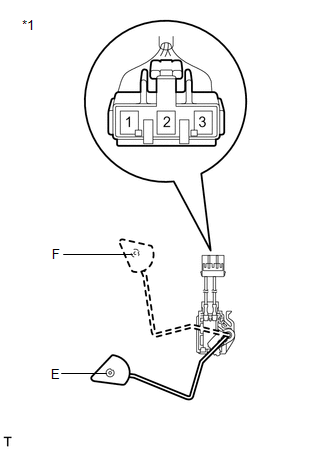 Text in Illustration
Text in Illustration
|
*1 |
Component without harness connected (Fuel Sender Gauge) |
(a) Remove the fuel sender gauge.
(b) Check that the float moves smoothly between F and E.
(c) Measure the resistance between terminals 2 and 1 of the connector according to the value(s) in the table below.
Standard Resistance:
|
Float Level |
Resistance (Ω) |
|---|---|
|
F |
6.5 to 8.5 |
|
Between E and F |
6.5 to 187.2 (Gradually changes) |
|
E |
183.2 to 187.2 |
If the result is not as specified, replace the fuel sender gauge.
2. INSPECT FUEL SENDER GAUGE ASSEMBLY
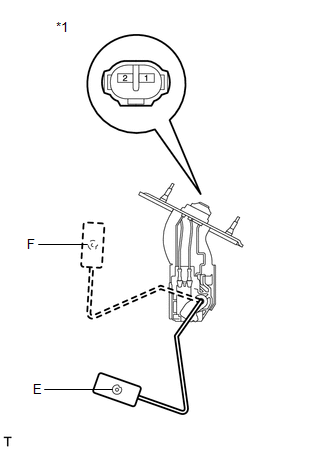 Text in Illustration
Text in Illustration
|
*1 |
Component without connected (Fuel Sender Gauge Assembly) |
(a) Remove the fuel sender gauge assembly.
(b) Check that the float moves smoothly between F and E.
(c) Measure the resistance between terminals 1 and 2 according to the value(s) in the table below.
Standard Resistance:
|
Float Level |
Resistance (Ω) |
|---|---|
|
F |
6.5 to 8.5 |
|
Between E and F |
6.5 to 227.3 (Gradually changes) |
|
E |
222.3 to 227.3 |
If the result is not as specified, replace the fuel sender gauge assembly.
Installation
INSTALLATION
PROCEDURE
1. INSTALL FUEL SENDER GAUGE ASSEMBLY
|
(a) Install the fuel sender gauge assembly to the fuel tank with the 6 bolts. Torque: 3.5 N·m {36 kgf·cm, 31 in·lbf} NOTICE: Be careful not to bend the arm of the fuel sender gauge assembly. |
|
2. INSTALL REAR NO. 2 FLOOR SERVICE HOLE COVER
|
(a) Connect the fuel sender gauge connector. |
|
(b) Install the rear No. 2 floor service hole cover with new butyl tape.
3. INSTALL FUEL SENDER GAUGE
|
(a) Install the fuel sender gauge by sliding it downward. NOTICE: Make sure that the fuel sender gauge arm does not bend. |
|
(b) Connect the connector of the fuel sender gauge.
NOTICE:
Do not damage the wire harness.
4. INSTALL FUEL SUCTION TUBE ASSEMBLY WITH PUMP AND GAUGE
(a) Install the fuel suction tube assembly with pump and gauge (See page
.gif) ).
).
5. CONNECT CABLE TO NEGATIVE BATTERY TERMINAL
NOTICE:
When disconnecting the cable, some systems need to be initialized after the cable
is reconnected (See page .gif) ).
).
6. INSPECT FOR FUEL LEAK
.gif)
 Installation
Installation
INSTALLATION
PROCEDURE
1. INSTALL FUEL SUCTION TUBE ASSEMBLY WITH PUMP AND GAUGE
(a) Install a new fuel suction tube set gasket onto the fuel tank.
(b) Connect the fuel tube with the cl ...
 Fuel System
Fuel System
...
Other materials about Toyota Venza:
Front Passenger Side Seat Belt Warning Light Malfunction
DESCRIPTION
The occupant classification ECU detects the state of the front seat inner belt
assembly RH and load sensor when the front passenger side seat is occupied with
the ignition switch ON. If the front passenger side seat belt is not fastened, the
...
Slip Indicator Light does not Come ON
DESCRIPTION
The skid control ECU is connected to the combination meter via CAN communication.
WIRING DIAGRAM
Refer to Slip Indicator Light Remains ON (See page
).
PROCEDURE
1.
CHECK CAN COMMUNICATION SYSTEM
(a) Check if ...
Indicators and warning lights
The indicator and warning lights on the instrument cluster and center panel
inform the driver of the status of the vehicle’s various systems.
For the purpose of explanation, the following illustration displays all indicators
and warning lights illuminat ...
0.1483

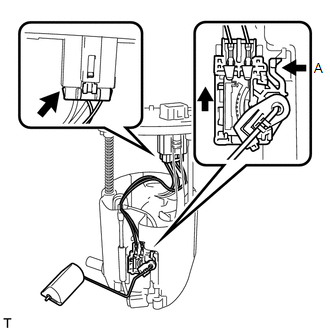

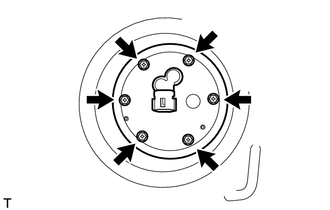
.png)
.png)
